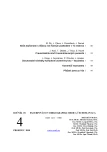Our Experience With Wound Healing Using the Controlled Vacuum Method at the Traumatology Centre of the University Hospital Ostrava
Authors:
Milan Šír; Leopold Pleva; Jana Pometlová; Jiří Demel
Authors‘ workplace:
The Traumatology Centre of the University Hospital Ostrava
; Traumatologické centrum Fakultní nemocnice Ostrava
Published in:
Úraz chir. 18., 2010, č.4
Overview
Aim:
To evaluate the experience with wound healing at the Traumatology Centre of the University Hospital Ostrava using the VAC controlled vacuum method (Vacuum Assisted Closure).
Materials and methods:
The authors retrospectively evaluate a group of patients treated with the VAC method at the septic part of the Traumatology Centre of the University Hospital Ostrava in the period between 2009 and 2010. We provided treatment for 41 patients altogether, 27 men and 14 women, with the mean age of 48,7 years. The most frequent indication for the treatment was a dehiscence of the operation wound, including limb loss injuries, posttraumatic osteomyelitis following open fractures, chronic defects of soft tissues, major injury dilacerations of soft tissues, 2 patients were treated for an ankle joint empyema with MRSA infection, one patient was referred for the treatment due to an enterocutaneous fistula.We provided debridement of the wound in all patients prior to the application of the VAC system. We used the VAC method in at least three applications after 3-4 days in every patient.
Results:
In accordance with the literary data, we noted an increased growth of granulation, which enabled a shortening of the total treatment period prior to a planned closure of the wound or a soft tissue grafting, depending on the character of the original defect. We have noted an exceptionally fast growth of granulations especially in posttraumatic defects of soft tissues, a thing we had never noted before. Based upon our experience, we may confirm, that the VAC method brings and increased comfort of the treatment for patients, especially in the means of a less frequent need for the change of dressings and decreased pain.
The method is more comfortable also for the staff, as the VAC system is very user friendly and easily operated.
Our work is more of an informative character, as it is our first experience with the method, having used the system for two years. Considering the various aetiologies of the wounds included in our patient group, we did not create a comparative group. The aim of our work was not to confirm the outcomes of the treatment, as these have already been presented in clinical trials and case reports.
Conclusion:
We have validated the quality of wound healing using the VAC system in the conditions of a Traumatology Centre. The patient group is highly variable, however we have acqui-red a positive outcome in most of the subjects. The VAC system is easily applied, is user friendly and brings smaller demands for the nursing staff, especially due to the decreased frequency of changing the dressing. The patients tolerated the VAC method very well. Apart from the comfort, the limited frequency of changing the dressings is also associated with a decrease in the pain, which is one of the monitored quality indicators of the provided hospital care. The VAC method has been used at our Centre na-mely for the treatment of soft tissue loss wounds caused by highly energetic injuries, as a preparation for the final closure of the wound.
Key words:
wound healing, granulation tissue, VAC method.
Sources
1. James, P., Stannard, MD. at al. Negative Pressure Wound Therapy After Severe Open Fractures: A Prospective Randomized Study. Division of Ortho-paedic Surgery, University of Alabama at Birmingham, Birmingham, AL. J Orthop Trauma. 2009, 23, 552–557.
2. James, P. Stannard, MD. et al. Negative Pressure Wound Therapy to Treat Hematomas and Surgical Incisions Following High - Energy Trauma. Department of Surgery, Orthopaedic Division, University of Alabama at Birmingham, Birmingham, Alabama. J Trauma. 2006, 60, 1301–1306.
3. PLEVA, L., MAYZLÍK, J. Poranění cév a kompartment syndrom. Praktr flebol. 10, 2001, 154–157.
4. PLEVA, L., ŠÍR, M., HOLEŠ, D. Pánevní kompartment syndrom. 23. Sympozium ortopedické kliniky IPVZ Praha Na Bulovce, 16. –17. 11. 2001, Praha. Abstract book, s. 46.
5. PLEVA, L., MAYZLÍK, J., ŠÍR, M. Léčení kompart-ment sydromu u polytraumatu. VI. Slovenský kongres cévní chirurgie s mez. účastí. 23.–24. května 2002, Košice, SR. Abstract book. s. 28.
Labels
Surgery Traumatology Trauma surgeryArticle was published in
Trauma Surgery

2010 Issue 4
- Metamizole at a Glance and in Practice – Effective Non-Opioid Analgesic for All Ages
- Safety and Tolerance of Metamizole in Postoperative Analgesia in Children
- Possibilities of Using Metamizole in the Treatment of Acute Primary Headaches
- The Importance of Hydration in Wound Healing
- Metamizole in perioperative treatment in children under 14 years – results of a questionnaire survey from practice
Most read in this issue
- Long-term consequences of complex talus fracture – case report
- Our Experience With Wound Healing Using the Controlled Vacuum Method at the Traumatology Centre of the University Hospital Ostrava
- Preventable death of trauma patients
